
Joel Ross, #UC!*&+%, 2012
Not How It Happened by Chicago-based Joel Ross and Jason Creps, currently on view at Tiny Park gallery in Austin, is at once, a drawing, sculpture, and photography exhibit. Its core, however, is text-based signs with three distinct modes of circulation: preparatory, sparse drawings; sculptural signs-objects; and large-scale photographs that capture the relationship between the signs and their chosen surroundings. The artists are trespassers who place their messages in carefully selected locations, often in the borderline between public and private space. While the drawings and photographs are destined for the institutional spaces of art, the signs are left in situ to be discovered by passersby. These works construct uncommon situations that provide an opportunity for a remarkably intimate and honest interaction.
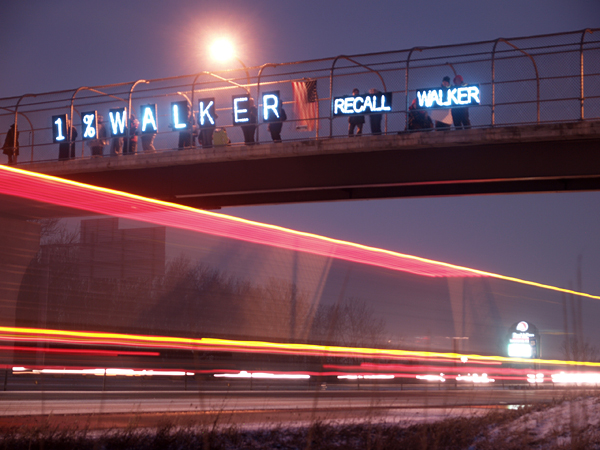
Overpass Light Brigade installation, 2012, Appleton, Wisconsin
When I think of text-based works that intervene in urban space, what first comes to mind are critical, political punch lines: works that appropriate and subvert the language of advertising in order to effect change. An iconic example might be Guerilla Girls’ use of billboards to decry absence of women artists in the MoMA’s collection. More recently, the snappy one-liners of Wisconsin’s Overpass Light Brigade are cases of clear-cut, activist messages: “1 % WALKER- RECALL WALKER”.
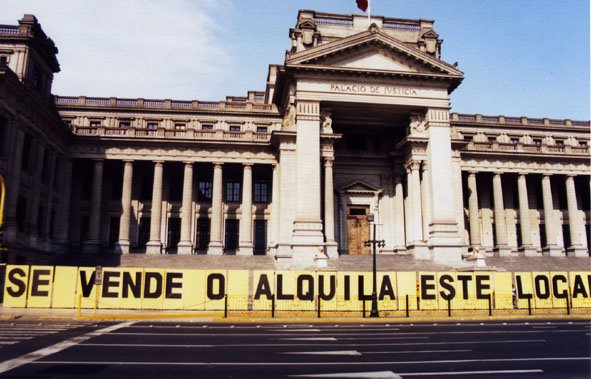
Lalo Quiróz, Se Vende O Alquila Este Local (For sale or rent), 2006. Lima, Perú
Another memorable urban intervention was an action in 2006 by the Peruvian artist Lalo Quiróz, in which a yellow-clad human procession marched a giant sign reading “This place is for sale or rent” (Se vende o acquila este local) in front of the most important governmental institutions in downtown Lima, including the governmental palace, congress, and ministry of justice.
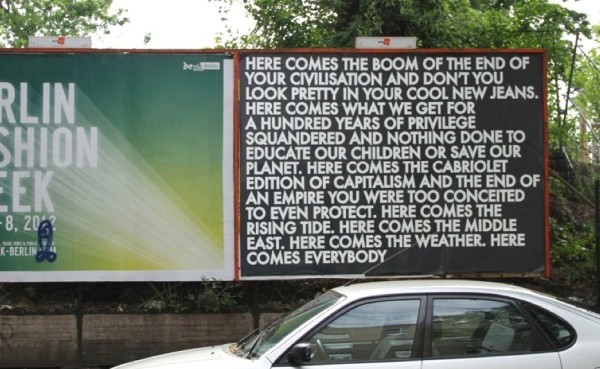
Robert Montgomery, billboards in various European locations, 2012
At the more poetic register, I envision the long-winded, nostalgia-infused, dramatic billboard pieces by Scotsman Robert Montgomery.
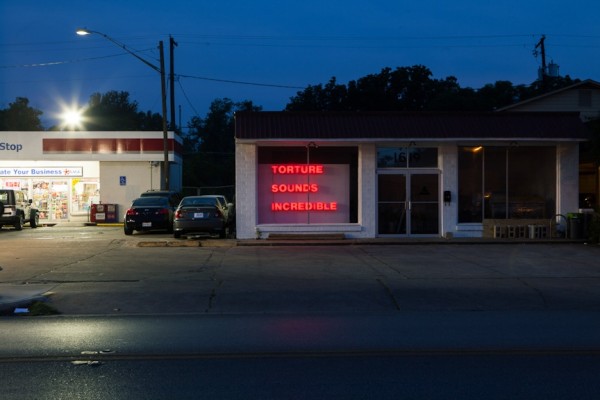
Ross and Creps, Torture Sounds Incredible, 2006 (installed currently at 1619 E Cesar Chavez, Austin, TX)
I bring up these examples to show what Ross and Creps’s works are not: not explicit, not critical, not didactic, not straightforward, and not very spectacular. “Torture sounds incredible” reads one LED-light sign installed offsite, at the storefront at 1619 East Cesar Chavez. It is a perfect representation of the artists’ murky politics. Torture might be incredible, but how? Jack-Bauer-style incredible? Zero-Dark-Thirty-type incredible? Incredible, because we actually don’t want to believe torture happens? Or are the sounds that torture produces incredible in themselves?

Ross and Creps, Not How it Happened, (installed and abandoned, Chicago, Illinois)
Ross and Creps’s messages are elusive and allusive. Yet, they almost always invoke the absent “you”: the viewer/reader that will come across their signs, be it on the roadside or in the gallery space. The piece from which the exhibition borrows its title teases: “AT THE BEGINNING OF THE STORY I WILL SAY TO YOU: ‘THIS IS NOT HOW IT HAPPENED’ AND THEN WE WILL PROCEED OKAY?” It is the particular tone and rhetoric of the work that makes it compelling. These texts do not address the generalized mass public in order to fix or amend their ways. Rather, they appeal to “you” on an intimate, personal level and scale.
Relying on a colloquial, everyday language, these texts are something like a pick-up line you might hear in a bar: sort of witty, sort of playful, sometimes confessional, sometimes cocky, vaguely promising you something. For example, “IT WAS A BAD IDEA … WE DID IT ANYWAY” hints at a possibility of hearing a good story. If you like these texts, if you respond to them, you can literally take them home with you: the signs are made on a small, do-it-yourself scale so that anyone with a hatchback can snatch and carry them away.
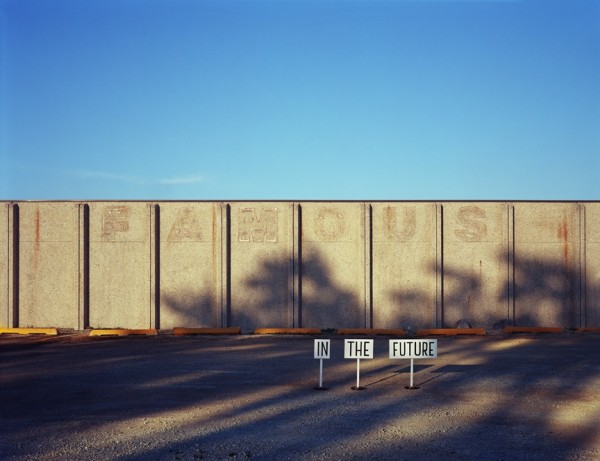
Joel Ross and Jason Creps, IN THE FUTURE (installed and abandoned, Bradley, Illinois), 2012.
The locations that Ross and Creps choose for their signs reinforce the everyday character of the conversations they invite. Rather than in highly visible, iconic urban sites, their signs function in the peripheries of the city and in suburban and semi-urban areas: strip malls, defunct parking lots, boarded up warehouses. “In the future,” a piece installed and abandoned in Bradley, Illinois (a village some 60 miles south of Chicago), embodies the corroded dreams of Middle America. The tripartite sign by Ross and Creps completes, tongue in cheek, the promise made by the defaced store sign that spells out “FAMOUS,” to read “FAMOUS in the future,” but emphatically not now (or any time soon). This ironic attitude encapsulates the anxieties and disillusionment that underlie the post-industrial Rust Belt, but might not be immediately felt in booming Austin. It also reflects the unease of an everyperson (an art professional, perhaps?), working towards, but not included in, any top-ten or sought-after list.
It is especially poignant that the works’ economic roles are made very transparent. The signs themselves, once placed in the chosen location, photographed, and abandoned, are up for grabs. Anyone can pick them up unless a city cleanup crew beats them to it. On the other hand, the large-scale photographs on display in the gallery are grandiose and lush: unapologetic perfect art objects, aware of their sex appeal. They can elegantly fit any high-ceiling, white-walled, contemporary space. This transparency in relation to both the informal open exchange and the market makes Ross and Creps’s work exceptionally honest. I see it as a healthy opposite of ostensibly political work favored in recent years by international art biennials (like last year’s Berlin Biennale for Contemporary Art or dOCUMENTA 13 in Kassel), in which the economics and the interests of corporate and private sponsors and patrons remain perfectly opaque to the public.
In contrast to unabashedly didactic messages transmitted by the high-end, impenetrable institutions, Ross and Creps create conversations for me and you (and everyone we know): seductive but not pretending to be what they are not.
“Not How It Happened” by Joel Ross and Jason Creps runs through June 22 at Tiny Park (1101 Navasota Street, Suite 2) in Austin. The gallery is open on Saturdays from 12pm to 5pm and by appointment.
Images courtesy of the artists and Tiny Park.


